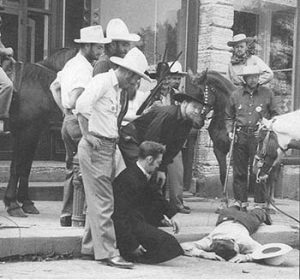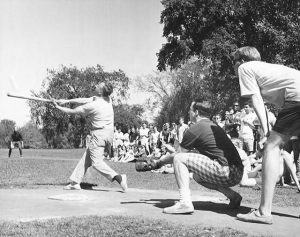 Within six years of the founding of Northfield in 1855, Northfield proudly flew its first U.S. flag. The Continental Congress had adopted the nation’s flag on June 14, 1777, and since Betsy Ross was not available to sew a flag for Northfield, a group of church ladies volunteered for the task and the first flag was unfurled on July 3, 1861.
Within six years of the founding of Northfield in 1855, Northfield proudly flew its first U.S. flag. The Continental Congress had adopted the nation’s flag on June 14, 1777, and since Betsy Ross was not available to sew a flag for Northfield, a group of church ladies volunteered for the task and the first flag was unfurled on July 3, 1861.
The story of this flag and its adventurous, if brief, life provides a window into the pioneer days of our community.
With the Civil War in its early stages, patriotism was on the rise and Northfield was determined to have its own flag and a municipal flag pole for use during holidays. Pages from a ledger of one of Northfield’s first businesses, the Skinner Brothers Store (established in 1856 on the current Armory site), show the costs to the penny of this endeavor:

25 1/3 yards of bleached muslin at 11½ cents – $2.9217 yards of Blue Delaine at 20 cents – $3.40
28 yards of Turkey red at 20 cents – $5.60
9 yards of Bleached Cotton at 11½ cents – $1.04
3 spools of thread at 5 cents – $.15
1 spool of thread at 5 cents – $.05
1¼ yard Blue Delaine at 20 cents – $.25
1 ¼ yard Beo Dill – $.14
1 rope – $.12
Pole – $1.60
Two spools of thread returned (credit) – $.10
Total: $15.17
The “Liberty Pole,” as it was called, was set up in front of the American House, a hotel built by town founder John W. North in 1857 at Third and Washington streets. The flag was stored either at the Lyceum Building on 4th Street or the Congregational Church known as the “Old Brown Church,” which stood on the northeast corner of Fourth and Washington streets from 1862-1880.
Mrs. Charles Bierman, whose scrapbook at the Northfield Public Library provides a wealth of information about early Northfield, tried to track down the story of the first flag and reached a man named William Cleveland, age 79, then living in Milbank, S.D. Cleveland wrote two letters to her in the summer of 1915, detailing what had happened.
Cleveland confirmed that the flag was first raised on the evening of July 3, 1861, when he was 25 years old. He wrote that when they were ready to raise the flag on July 4, 1862, “the rope had been stolen, so they hired Felix Collett to adjust a new rope. He did this with the help of ladders, which he lashed together and climbed.” It was no small chore since the first rope had been placed in the 115-foot pole when it was on the ground.
Then, on Independence Day of 1863, the rope was once again missing. Collett had been paid $25 the previous year and, wrote Cleveland, “…it having cost so much to place the rope the year before, the committee had decided to raise a new pole and had the material on the ground.” Cleveland happened by and offered to climb the old pole and put the rope up for $5. Although skeptical, they agreed, and Cleveland “skinned up” the wooden pole and said he had the flag flying before eight o’clock. Cleveland did not know how the $5 was raised but remembered, “We had a good celebration that day.”
Cleveland wrote, “That was the last time the liberty pole was used on the fourth, for a few weeks later during harvest I had been in the country working in the field and was on my way to town when I noticed the pole (which had stood in front of the American House) was gone.” It had been struck by lightning and tall splinters were all that were left. A lag-bolt which had been at the top of the pole had been driven down through the full length of the pole to rest in the heart of the splinters.
The fate of the flag is unknown, although there has been speculation that the flag may have burned in one of two fires at the Old Brown Church where it was stored, either a minor fire in 1869 or when the church was totally destroyed in 1880.
As flags fly for the Fourth of July this year, take a moment to think of the hand-sewn Old Glory which first flew 148 years ago on Northfield’s Liberty Pole.
Thanks to the Northfield Historical Society archives and to the Northfield Public Library for access to the Bierman scrapbook.
Northfield’s World Peace Flag
According to a February posting on a website devoted to flags of the world, an International World Peace Flag was designed by members of an organization called the World Peace Association which was formed in Northfield in 1915. The flag was a white flag with a three-inch red stripe at the top and bottom to outline the flag, with a globe in the center showing the Eastern and Western hemispheres. At the center of the globe was a dove and olive branch. The W.P.A. headquarters moved to Jenkins, Minnesota, sometime prior to 1930 and on May 12, 1938, the association applied for registration of a flag and changed the former flag design to five horizontal stripes of equal width, with stripes in descending colors of red, white, brown, yellow and black. Each stripe represented “one of the five different groups of the human race.” The flag became official on Nov. 5, 1939. The flag designed in Northfield in 1915 was discontinued due to the cost of manufacture.
The secretary-treasurer of the society when it was based in Northfield was C.A. Ryan, a contractor/carpenter. Ryan is described in a May 19, 1916, Northfield News story as a “militant peace advocate” who distributed fliers attacking the showing in town of a silent film drama called “The Battle Cry of Peace.” His efforts attracted large crowds to “see for themselves just what it was like…The film has been the leading topic of conversation in town for a week.”
It is not known today where the International World Peace Flag may have flown in Northfield, but it is an interesting side note to Northfield’s history of flags.






